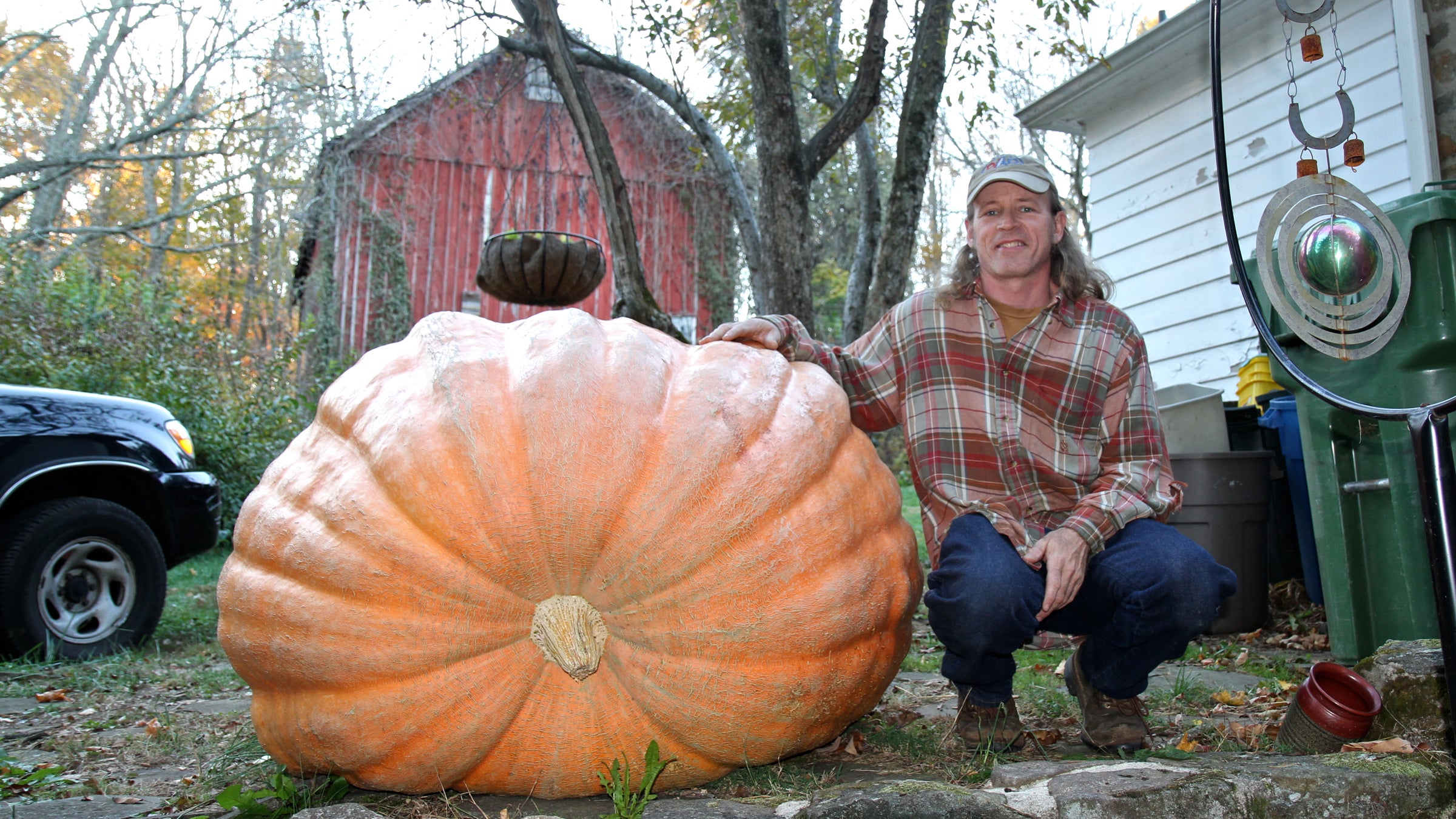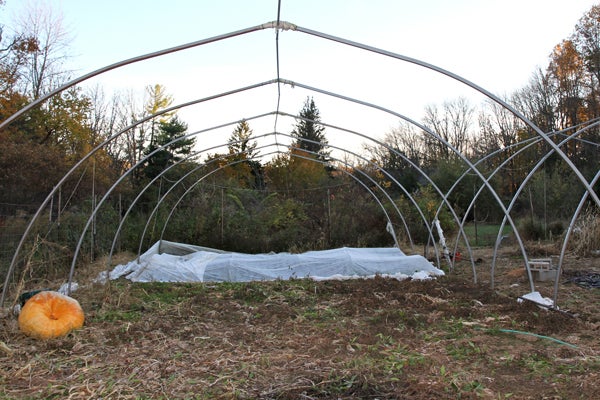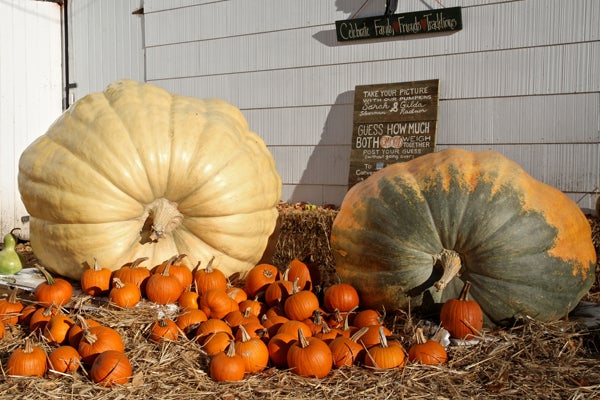Unlocking the secrets of growing a giant pumpkin
Listen
Alex McCracken shows off a giant pumpkin that mysteriously stopped growing early in the season at his Quakertown home. (Carolyn Beeler/WHYY)
The world-record pumpkin weighs almost double what it did ten years ago, due, in part, to growers sharing their secrets.
In the past decade, the world record weight for a giant pumpkin has nearly doubled, shooting up to 2,323 pounds last year.
Giant pumpkin growers attribute these huge increases to fine-tuned genetics and growing techniques, and an increased willingness of hobbyists to share their secrets.
Gone are the days, they say, of gardeners booby-trapping their pumpkin patches to deter spying rivals.
“Pretty much all the growers that I know are pretty open about what they do,” said Alex McCracken of Quakertown, Pa., who has been growing giant pumpkins for about eight years.
“That’s one of the main reasons I think the weights have just kept going up and up so much.”
McCracken works for a produce delivery company and is starting his own gardening business, but his passion is giant pumpkins: he co-founded the Mid-Atlantic Giant Pumpkin Growers and won the weigh-off at the South Jersey Pumpkin Show earlier this month. Last year, he grew a whopping 1,389 pound pumpkin.
On a trip to his Quakertown home this week, McCracken shared his giant pumpkin-growing secrets.
Giant pumpkins require seeds with a pedigree
All competitive giant pumpkins are from the Atlantic Giant variety, which was bred for size, but the biggest pumpkins come from seeds with a pedigree.
“Each giant pumpkin seed has its own family tree basically,” McCracken said. “It’s exactly like champion dog breeding or thoroughbreds.”
Websites publish seed family trees, where you can enter in the name of a seed and trace its lineage several generations back, McCracken said.
Competitive growers trade seeds, use their own from old fruit, or buy them at special pumpkin seed auctions.
Seeds from the 2014 world-record holding pumpkin sold for more than $500 last fall.
McCracken mostly uses his own seeds, which he stores in coffee canisters labeled with their genetic history, but he has bought them before. The most he’s ever spent on a single seed is $80.
“That one rotted about a week before the weigh-off,” McCracken said. “That’s one of the things you have to get used to growing giant pumpkins is heartaches, because there’s plenty of those along the way.”
McCracken plants his seeds inside, under a heat lamp in mid-April. Around the beginning of May, he takes the seedlings outside and plants five of them in the pumpkin patch up a hill and behind his house.
This time of year the patch is a large plot of bare dirt. But during the growing season, each plant, 600 to 700 square feet of vines and roots, has been pruned back until it is funneling all of its water and nutrients into a single pumpkin by mid-July.
“You do put all your eggs in one basket really early,” McCracken said.

Alex McCracken’s hoop houses are covered during the growing season to protect his pumpkins from pests. (Carolyn Beeler/WHYY)
Feeding and protecting the pumpkin
Keeping his giant pumpkins fed, watered and protected takes serious dedication and about 20 hours a week during the growing season.
“A lot of people call it being a pumpkin widow,” said McCracken’s fiancé Jill Redding. “Which I disagree with only because his passion is so strong and he loves it so much that it’s actually kind of an honor to be with someone that has such a cool hobby.”
Still, week-long summer vacations are out for McCracken, Redding and her two children.
McCracken feeds his pumpkins seaweed, calcium and potassium fertilizers. Some growers are now applying hormones to their plants to experiment with increasing cell division early in the fruit’s development.
Later in the season, McCracken builds brick towers to support the vines so they don’t tug at the pumpkins, and sprinkles rings of a mouse-repelling powder made of red pepper, blood meal and garlic around each fruit.
To prevent rot, McCracken runs 400-foot extension cords to his pumpkin patch to power fans blowing on pumpkin stems and stumps.
“This is something I laughed at other growers for doing and swore I would never do,” McCracken said. “But now I do that pretty religiously every year.”
All the work is worth it, McCracken said, because of the magic of creating something so huge out of dirt, sunlight, water and a lot of labor.
“The fascination of starting out with this little tiny seed that you can hold in your hand, and then within a few months you’ve got something growing in your garden that’s almost as big as your car,” McCracken said. “I guess it’s just the little kid in me maybe that’s fascinated by that.”
Giant pumpkins start out round, but as they start putting on serious weight, around 30 or 40 pounds a day, they flatten out due to the force of gravity pulling down on their massive bodies.
Jessica Savage, a post-doctoral fellow at the Arnold Arboretum in Boston, has studied the giant pumpkins’ vascular system, the plant equivalent of veins, and found they are especially dense.
“What we found was, when you looked at the giant varieties of pumpkins that have been bred for competitive growing, they actually had more of the vascular tissue that transports sugar in them,” Savage said of research published this year.
More vascular tissue means there are more pathways for sugar to get to the pumpkin and make it grow faster.
“So [giant pumpkins] have a higher capacity to move sugars and carbon into their fruit than the smaller squashes,” Savage said.

Alex McCracken’s prize winning pumpkins are on display at Max Hansen Carversville Grocery. (Carolyn Beeler/WHYY)
Getting the giant to a weigh-off
The final step in producing a giant pumpkin is getting it out of the patch, usually with a fork-lift and harness, and to a weigh-off. Most giant pumpkin competitions happen between the end of September and mid-October.
McCracken’s prize-winning pumpkin from the South Jersey pumpkin weigh-off this fall is on display outside a general store in Carversville, Pa., where guests can win a gift certificate by guessing the combined weight of the prize pumpkin and a second, smaller one.
“Everybody thinks that they’re fake, and then they come and feel them and they realize that they’re real,” said cashier Lily Tomlinson.
The disbelief is understandable: McCracken’s big pumpkin is waxy yellow, stands chest high, and is as big around as a kitchen table.
“The weights just keep going up and up and nobody really knows yet where the upper limit is of these things, so it’s kind of fascinating to keep pushing it and see how far they can go,” McCracken.
About five years ago, Georgia Tech engineers tried to model how big giant pumpkins could get, and concluded that it was impossible to find the upper limits of their growth with current technology.
At least for now, just how giant the giant pumpkin will grow remains a mystery.
WHYY is your source for fact-based, in-depth journalism and information. As a nonprofit organization, we rely on financial support from readers like you. Please give today.



